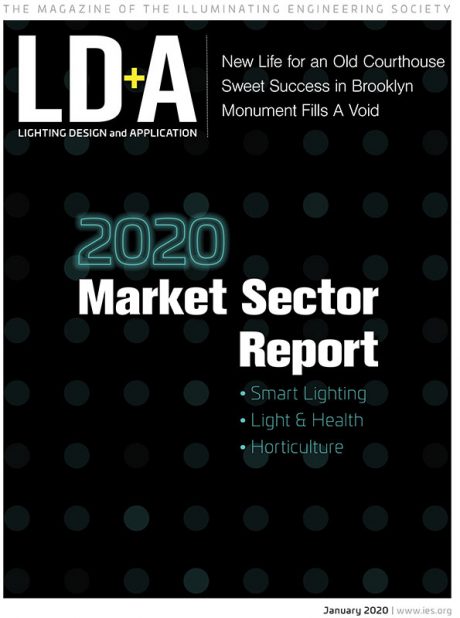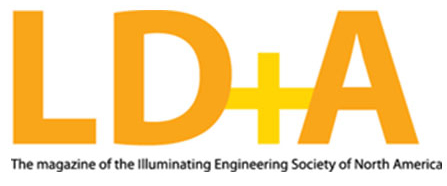LIGHTING DESIGN AND APPLICATION, JANUARY 2020 ISSUE: 2020 Market Sector Report
An article from the January 2020 issue of LD+A focusing on the emerging field of horticulture lighting.
Lorem ipsum dolor sit amet, consectetur adipiscing elit. Nam eu hendrerit nunc. Proin tempus pulvinar augue, quis ultrices urna consectetur non.
WHERE WE ARE
For horticulture lighting, “growth” isn’t just the market forecast—it’s the basis for the market itself. Light has always been integral to plant cultivation, but LEDtechnology has helped lighting secure a new foothold in the evolving field.
“While the demand for LED horticulture lighting isn’t growing exponentially like everyone thought a few years ago, LEDs have clearly established their value in the horticulture industry,” says Paul Scheidt, leader of the product marketing team for the LED Components division of Cree. “LEDs can boost yields, save energy and last longer than any other technology available on the market.”
Ron de Kok, director of North American Horticulture LED Solutions at Signify, agrees these are just a few of the reasons “growers are looking for an easy way to step into LED lighting,” while David Cohen, CEO of Fluence by OSRAM, notes that many growers have already made the switch. “Global cultivators are no longer evaluating the efficacy of LED lighting solutions. They are demanding it,” Cohen says. “For commercial crop growers operating under tight margins, LEDs produce sought-after products that command increased revenues. For commercial cannabis growers, our research indicates that cultivators are ranking energy efficiency and light intensity as critical factors when making lighting purchases—factors in which LED
lights excel.”
Researchers, however, are still studying up on LEDs. “The horticultural lighting market is still experimenting with different spectral power distributions, including far red, UV, white LEDs and integration of sensing modalities,” explains Dr. Ziggy Majumdar, director of development for the Lighting Research Center at RPI. “A significant element appears to be algorithms to control the lighting systems, since there are many different crops and properties growers seek to optimize. This could be maximizing yield with the least amount of energy, or other crop characteristics, such as color, shape, flavor or medicinal compounds.”
A less talked-about factor is using light to ward off crop disease. “Our surveys also suggest that disease is an important factor, which includes pathogens such as downy mildew and powdery mildew,” Majumdar adds. “Using lighting strategies to prevent disease and reduce severity has been of interest to our industry partners and within the LRC. Horticultural lighting of the future may look very different and vary greatly across crops, so there are many interesting research questions and design strategies to explore.” Chris Bishop, president of Illumenedge Lighting Agency, an Ontario-based designer and specifier of horticultural lighting solutions, says big-picture questions posed by researchers such as Majumdar have made interest in horticulture lighting higher than ever. “With issues like the inevitable food shortage crisis of the near future in mind, horticulture lighting helps us acknowledge issues, identify solutions and present innovative options like vertical indoor vegetable factories or insect-protein farming. We are just beginning to understand and explore the possibilities that horticulture lighting can provide.”
FORECAST
The future of the market depends on a range of evolving factors. “Cost of fixture production and profits of the growers are obvious factors that affect market growth, and competition may increase with more companies getting into the market,” Majumdar explains. “Consumer preferences for local, sustainable and ‘chemical free’ will be a growth driver. Climate change may favor more indoor production of specialty crops. I think what will hurt novel products are advertising claims without good evidence. This creates confusion and when results do not meet expectations, growers veer away from premium products, which can create a ‘race to the bottom’ in terms of cost.”
For LED manufacturers, creating premium products comes with challenges. “The LEDs need to be very efficient, very bright and last a very long time under harsh conditions to make the business case for more expensive LED products that work for the growers,” Scheidt says. “Not every LED is up to the challenge.”
However, Scheidt and other manufacturers see
potential. “We know from how LEDs were adopted in general lighting that carrots (LED luminaire rebates) and sticks (regulation updates) are both effective tools until the prices of LED-based products are able to come down. Once the LED products get less expensive, then they will just become the default choice moving forward. I don’t see anything that would
disrupt this process; however, I think this is all a very narrow view of the potential of LEDs for horticulture.“ Horticulture seems to be on the brink of a massive change in where and how food or medicine is produced,” Scheidt continues. “And LEDs seem to be an integral part of, or even the catalyst for, these new plant growth techniques. The potential health and
environmental benefits are huge and very exciting, but getting there requires some major disruptions in industries that will be resistant to change. It’s anybody’s guess on how it will play out in the next 10 years or so, but I am confident that LED-based lighting will be an important component of any new technique.”
The cannabis industry is already grappling with questions about how supply can best meet demand. “The continued adoption of medical marijuana programs and legalization of cannabis across the globe has already and will continue to rapidly expand interest, innovation and investments across horticulture lighting as a whole,” Bishop says. However, both Bishop and Cohen acknowledge hurdles to overcome.
“The cannabis market in particular is still young, and cultivators are still identifying and standardizing best practices across every area of cultivation, including supplemental lighting,” Cohen says. “How quickly they are able to establish those best practices will be a significant factor in how quickly cannabis markets grow around the world.
“Taking it one step further, there’s a fundamental need for more in-depth research around the efficacy of horticultural lighting systems like LEDs, and this is true across both cannabis as well as commercial food and crop-production verticals,” Cohen adds. “Now that LEDs are truly affordable for cultivators of all kinds, the next step is to usher in a new wave of research that explores the efficacy of LED systems on crop yields, uniformity, cost-efficiency and other metrics that will help cultivators expand their profit margins.”
Additional research will vary based on technology, as well as crop, Majumdar notes. “In some crops, the lighting can still be highly energy intensive and increased deployment of renewable sources of energy may increase demand for higher efficiency lighting. For high-value crops, LED solutions still need to prove they can reliably create quality products and gain trust from growers to unseat incumbent technologies. This requires thinking about how other environmental variables are affected by the lighting system and how
that affects the crop. It may be a good time to consider UV-B and UV-C LEDs to reduce disease without chemicals in high value crops where this may be a capability gap, since their operations may be less cost sensitive.”
One opinion emerges as unanimous: Creating the “right” LED systems for horticulture is worth it, because it makes sustainable crop cultivation possible. “You can’t always depend on Mother Nature to provide the optimal light you need for growth,” de Kok emphasizes. “The right LED luminaires can complement natural light, with the spectrum and intensity that fruit and vegetables, for example, need, without adding extra heat. Or provide the finely tuned light recipes to stabilize and improve plant quality during winter months. LED lighting will make it possible to support increasing consumer demand for locally grown produce all year round.”



